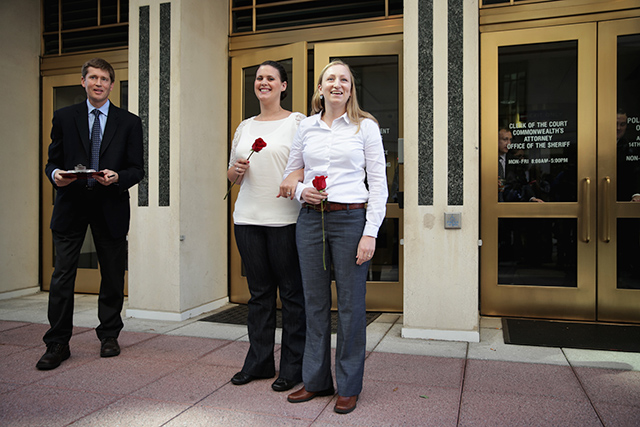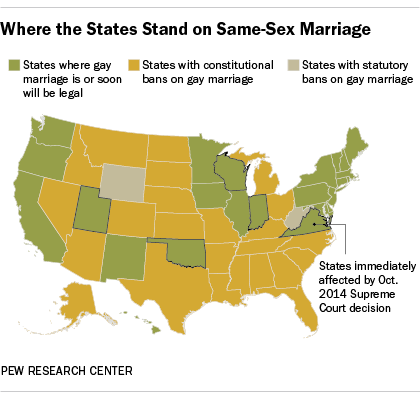

The U.S. Supreme Court today rejected requests to review lower court decisions that overturned bans on same-sex marriage in five states: Indiana, Oklahoma, Utah, Virginia and Wisconsin. By denying these requests, the court effectively legalized gay marriage in these states. The lower court rulings had been on hold until the Supreme Court weighed in, but soon after the high court’s decision was made known, a number of states, including Virginia and Wisconsin, announced that gay and lesbian couples would be able to marry almost immediately.
While today’s decision settles the issue in some states, it has not ended the battle over same-sex marriage. Here is an explainer of today’s news and its possible impact.
Has the Supreme Court approved same-sex marriage across the country? No, it hasn’t. When the high court decides not to hear a case, it is possibly, but not necessarily, a sign that a majority of the justices agree with the lower court’s ruling. The court can deny petitions for it to hear a case based on other reasons, including when there is no split among the federal circuit courts of appeals, as was the case in this instance. The three federal appeals courts that have so far ruled on gay marriage bans – the 4th, 7th and 10th circuits – all agreed, saying that state bans on same-sex marriage are unconstitutional.
Beyond the five states directly impacted by today’s decision, how many states are affected? In the regions covered by the three federal appeals court circuits directly affected by today’s decision, there are six states – Colorado, Kansas, North Carolina, South Carolina, West Virginia and Wyoming – where same-sex marriage is still banned, but is likely to be legal soon because these states fall within the jurisdiction of courts that struck down the bans. For example, the jurisdiction of the 10th Circuit Court of Appeals covers Colorado, Kansas, New Mexico, Oklahoma, Utah and Wyoming. The same holds true in North Carolina, South Carolina and West Virginia, which currently ban gay marriage but fall within the jurisdiction of the 4th Circuit.
How does this affect other same-sex marriage cases pending in the courts? Many cases challenging state same-sex marriage bans in other circuits are still likely to move forward. It is unclear whether the Supreme Court’s action today will have any direct effect on the resolution of other cases challenging gay marriage bans. But the appeals court circuits that were not involved in today’s decision are not bound by it, and are free to continue to independently consider the constitutionality of state same-sex marriage bans. Currently, there are active challenges to same-sex marriage bans in every state where gay marriage is not legal.
Will the Supreme Court take another same-sex marriage case? Maybe. If one of the remaining circuits were to decide that state bans on same-sex marriage are constitutional, a split among the circuits would likely prompt the Supreme Court to take a gay marriage case. When there is disagreement among appeals court circuits, the Supreme Court usually steps in and agrees to resolve this split or disagreement among the circuits.
Does this mean same-sex couples will eventually have the constitutional right to marry? Not necessarily. It is still theoretically possible that the Supreme Court ultimately could rule against those who claim a constitutional right of same-sex marriage. Although today’s decision certainly suggests that the courts are moving toward nationwide recognition of same-sex marriage, the issue remains unresolved in roughly half of the appeals court circuits, and, at least for now, more than half of the states (26) still have gay marriage bans in effect.



